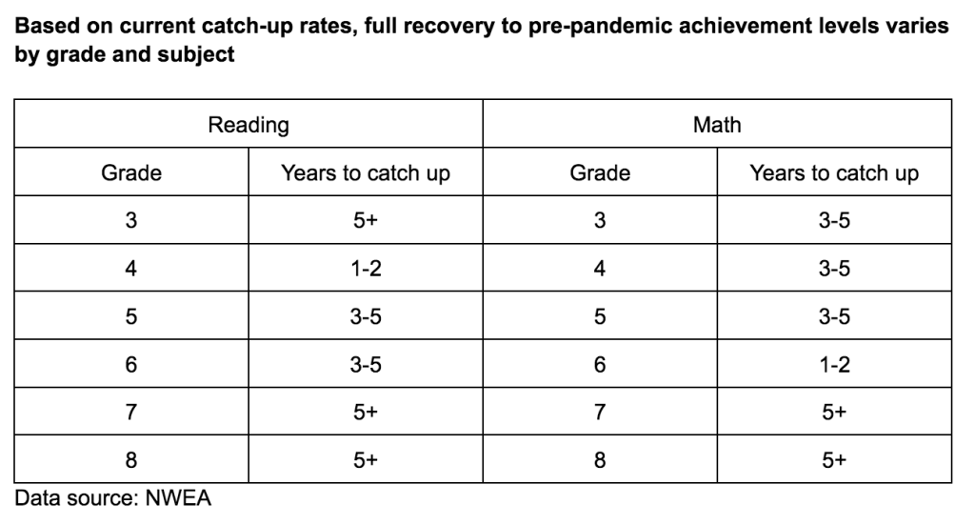One group of economists studied NWEA’s achievement data at the peak of learning loss in the spring of 2021 and estimated that fourth and fifth graders had fallen eight to 10 weeks behind in reading and math, respectively. Based on the subsequent catch up that NWEA documented in the spring of 2022, upper elementary school students might now be six to seven weeks behind.
However, some groups of students, especially middle schoolers, didn’t make such good progress. Students who completed eighth grade in the spring of 2022 fell 18 percent further behind in math compared to 2021. This suggests their math learning losses might have expanded from 19 weeks to 23 weeks – almost six months behind – as they start high school in the fall. Seventh graders also made no forward catch-up progress in math.

“Middle schoolers are where we see the most stagnation,” said Lewis. “It is certainly concerning. Those are the kids with the longest roadmap to catch up.”
Getting kids back on track academically is arguably one of the most important challenges our nation faces right now. The long-term economic and social costs are enormous if we fail. One group estimated that the U.S. economy could lose more than $128 billion a year, another worried that today’s generation of students risks losing $2 trillion in lifetime earnings.
This report doesn’t address why or how some students bounced back while others fell further. Eighth graders were in sixth grade when the pandemic first hit in the spring of 2020 and their mental health might have been more affected by pandemic isolation. At the same time, the material that students need to learn in middle school is more complex and the rate of learning slows.
Third graders posted more sluggish progress in reading than fourth and fifth graders. These third graders were in first grade when the pandemic hit in 2020 and were just learning to read. Based on their rate of progress, NWEA estimates that it will take more than five years to catch up. Third graders were the youngest students analyzed in this NWEA report, which tracked only children who were already enrolled in school before the pandemic hit in order to measure learning losses. We don’t know from this report if even younger children are suffering more.
Low-income students appeared to make as much achievement progress as higher income students. For example, fifth graders in high-poverty schools and low-poverty schools alike both improved by nine points on math tests. But low-income children, who were already behind before the pandemic, lost the most ground and their achievement gaps with higher income children are still gigantic.
“Students in low-poverty schools will likely recover faster as they have less ground to make up,” NWEA researchers wrote in their brief.
We also cannot tell from this report which catch-up interventions, such as tutoring and summer school, led to better learning progress. NWEA is working with outside researchers and is slated to issue its first report later this year. Perhaps those reports can help shed light on the best ways to help children who are behind catch up – whether there’s a pandemic or not.
This story about learning loss was written by Jill Barshay and produced by The Hechinger Report, a nonprofit, independent news organization focused on inequality and innovation in education. Sign up for the Hechinger newsletter.




